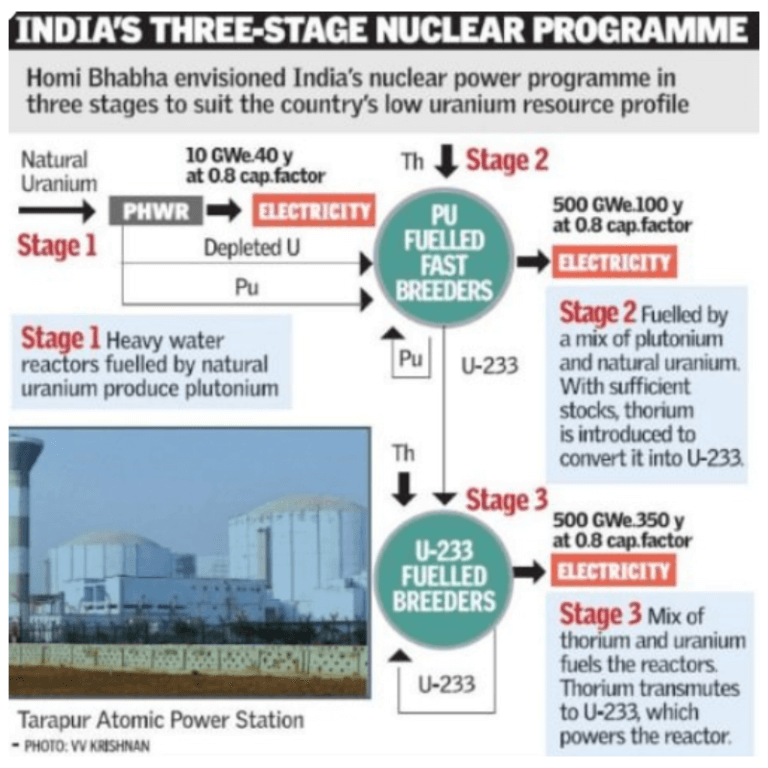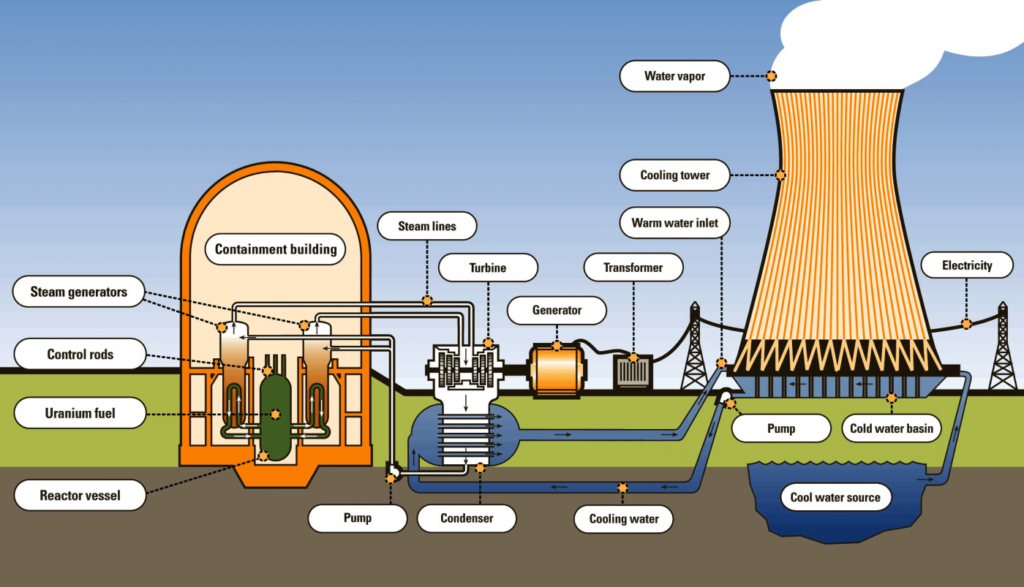The world has been experiencing a power and energy crisis recently. Although the specific causes of this catastrophe vary from nation to nation, the result has been a push to lessen reliance on fossil fuels and explore for workable alternatives. Nuclear energy has a lot to offer in this situation. Here is more information on nuclear energy.
Nuclear energy is thought to be the most effective method of producing energy to address the energy challenges.
Currently, nuclear energy supplies a significant amount of 24/7 carbon-free, emissions-free, and greenhouse gas-free electricity, which is vital for environmental protection. The cheapest, greenest, and safest form of energy now available to humans is nuclear energy.
How does nuclear energy work?
The energy found in an atom’s nucleus or core is known as nuclear energy. Atoms are the minuscule building blocks of all matter in the universe.
The energy found in an atom’s nucleus, or core, is referred to as nuclear energy. All everything in the cosmos is made up of microscopic building blocks called atoms, and the nucleus is held together by energy.
The compact nucleus of an atom has a tremendous amount of energy. In reality, the force that keeps the nucleus together is referred to as the “strong force” in official language.
Electricity can be produced using nuclear energy, but it first needs to be released from the atom. Atoms are divided during nuclear fission in order to unleash that energy.
How is nuclear energy made?
Nuclear fission is the technique used to release nuclear energy through atom-splitting.
A collection of devices that can manage nuclear fission to generate electricity is known as a nuclear reactor or power plant. Uranium pellets are the fuel that nuclear reactors utilise to generate nuclear fission.
Uranium atoms are split apart under extreme pressure in nuclear reactors. The atoms split, releasing little particles known as fission products.
Other uranium atoms break as a result of fission products, beginning a chain reaction. This chain reaction releases energy, which is converted into heat.
Nuclear fission generates heat, which warms the cooling fluid of the reactor. Normal cooling agents include water, but some nuclear reactors also use molten salt or liquid metal.
Steam is created when the cooling agent is heated by nuclear fusion. Turbines or wheels turned by a flowing river are rotated by the steam. The generators or engines that produce electricity are driven by the turbines.
The amount of electricity produced can be changed using rods of a substance known as nuclear poison. Nuclear poisons are substances that absorb some of the fission products produced by nuclear fission, such as a particular form of xenon.
The chain reaction will be slower and more under control the more nuclear poison rods are present at the time. By removing the rods, a stronger chain reaction and more electricity are produced.
Advantages of Nuclear Energy:
- Nuclear energy reliably generates electricity. Electricity must be available constantly if our country is to thrive in the twenty-first century. A crucial component is clean, dependable nuclear energy because it can operate continuously for 18 to 24 months at a time.
- Nuclear power produces jobs. More than 100,000 long-term, well-paying employment are supported by nuclear energy, and local economies get millions of dollars in state and local tax money.
- Nuclear power safeguards our air. You shouldn’t want mercury, nitrogen oxide, sulphur dioxide, particulate matter, or any of these substances in the air you breathe. 24/7 power is provided by nuclear energy, which is devoid of these contaminants.
- Nuclear power advances global development. Nuclear energy aids developing countries in achieving sustainable development objectives.
- Electric cars powered by nuclear energy. Carbon emissions are expected to be reduced by electrified transportation. Electric vehicles can operate at their maximum efficiency when supplied with carbon-free nuclear energy.
- Nuclear energy safeguards national security. Nuclear-powered submarines and aircraft carriers are used to meet a nation’s security needs while supporting a robust domestic electricity system.
- Space exploration uses nuclear power.
- It may be constructed in both urban and rural regions.
- used in the desalination process to produce drinkable water.
- Nuclear radiation is used to treat food by eradicating pathogenic bacteria, insects, and parasites. It is also used to treat cancer.
- Employed to sanitise medical equipment.
- Nuclear energy has the potential to significantly impact transportation by replacing fossil fuels.
Nuclear energy in India
After thermal, hydroelectric, and renewable forms of electricity, nuclear power ranks as India’s fourth-largest source of electricity.
Nuclear energy provides 2.5% of what India needs in terms of energy.
With a total installed capacity of 6780 MW, India’s 7 nuclear power stations house 22 operational nuclear reactors.
India was not included in the international nuclear commerce until 2009 since it had not ratified the Nuclear Non-Proliferation Treaty because of its nuclear weapons programme. The growth of India’s civil nuclear energy programme was hampered by this.

Locations of Nuclear Power Plants:
- Tarapur Atomic Power Station (MH) – First in India
- Kakrapar Atomic Power Station (GJ)
- (Kalpakkam) Madras Atomic Power Station (TN)
- Narora Atomic Power Station (UP)
- Kaiga Nuclear Power Plant (KR)
- Rajasthan Atomic Power Station (RJ)
- Kudankulam Nuclear Power Plant (TN)
Locations of Uranium Resources:
- Tummalapalle (Kadapa District) – Andhra Pradesh
- Nalgonda District – Telangana
- East Singhbhum District – Jharkhand
- West Khasi Hills District – Meghalaya
- Udaipur District – Rajasthan
- Yadgir District – Karnataka
- Rajnandgaon (District) – Chhattisgarh
- Sonbhadra district – Uttar Pradesh
- Rudraprayag District – Uttarakhand
- Una District – Himachal Pradesh
- Gondia District – Maharashtra
India’s three-stage nuclear programme:
India possesses some of the greatest supplies of thorium in the world as well as extremely little uranium reserves. In 1954, Homi Bhabha proposed a three-stage plan for India’s nuclear power development to take into account the country’s resource profile.
Launched in 1954, the Indian nuclear power programme envisioned a three-stage expansion of nuclear energy production using the nation’s uranium and thorium resources.
Heavy water reactors powered by naturally occurring uranium would create plutonium in the initial stage.
The first stage’s plutonium and natural uranium would be used as a starting fuel for the second stage.
Once there are enough stocks built up, thorium is added to the fuel cycle to transform this uranium into uranium 233 for the third stage, where it will transmute into more plutonium.(Transmutation is the nuclear reaction that changes an atom of one element into an atom of another). Scientists can cause nuclear transmutation by bombarding the nuclei with high-volume particles, a process known as induced nuclear transmutation.
The reactors are powered in the last phase by a thorium and uranium mixture. At the second stage, the thorium transforms to U-233, which powers the reactor.
Even though the U-233 is doing the fissioning to create power, fresh thorium can replace the depleted thorium in the reactor core, effectively turning it into a thorium-fueled reactor.
Components of nuclear power plant
There are several components common to most types of reactor:

Fuel
Uranium is the basic fuel. Usually pellets of uranium oxide (UO2) are arranged in tubes to form fuel rods. The rods are arranged into fuel assemblies in the reactor core.* In a 1000 MWe class PWR there might be 51,000 fuel rods with over 18 million pellets.
Moderator
Material in the core which slows down the neutrons released from fission so that they cause more fission. It is usually water, but may be heavy water or graphite.
Control rods or blades
These are made with neutron-absorbing material such as cadmium, hafnium or boron, and are inserted or withdrawn from the core to control the rate of reaction, or to halt it.
Coolant
A fluid circulating through the core so as to transfer the heat from it. In light water reactors the water moderator functions also as primary coolant
Pressure vessel or pressure tubes
Usually a robust steel vessel containing the reactor core and moderator/coolant, but it may be a series of tubes holding the fuel and conveying the coolant through the surrounding moderator.
Steam generator
Part of the cooling system of pressurised water reactors (PWR & PHWR) where the high-pressure primary coolant bringing heat from the reactor is used to make steam for the turbine, in a secondary circuit.
Conclusion :
- Thorium is a precious and crucial component of the nuclear fuel of the future, and India is fortunate to possess it. It cannot afford to miss the chance to become the global energy hub, which, when combined with the largest youth population, will be India’s response to becoming the world’s most powerful economy.
- The world was experiencing a power and energy crisis recently. Although the specific causes of this catastrophe vary from country to country, the result has been a push to boost the generation of renewable energy and decrease reliance on fossil fuels.
- But, the availability of these renewable resources around-the-clock requires a major reexamination of the current green energy paradigmDespite the fact that nuclear power may be the most affordable, environmentally friendly, and secure kind of energy currently available to humans.
- The word “nuclear” always elicits a negative, and frequently hysterical, reaction rather than a rational, fact-based one.Even though it is a cleaner fuel, nuclear power is not a top priority in India, which only accounts for 1.72% of the world’s installed nuclear capacity.
- The global energy crisis should encourage a logical reexamination of an energy source as obvious as nuclear, which is unnecessarily viewed as a contentious issue.
- All low-carbon technologies have some social and environmental effects, therefore we must choose the best ones.

Great article. Both pros and cons are covered under this article.
Very useful content👍
useful content👍
I have got Best information on nuclear energy👍
Woahh…! Since so many days i want an exact amount of information.And and after so many blogs and articles finally i found the exact amount of information that i need for my preparation.Thankyou Shakti institute.🙂